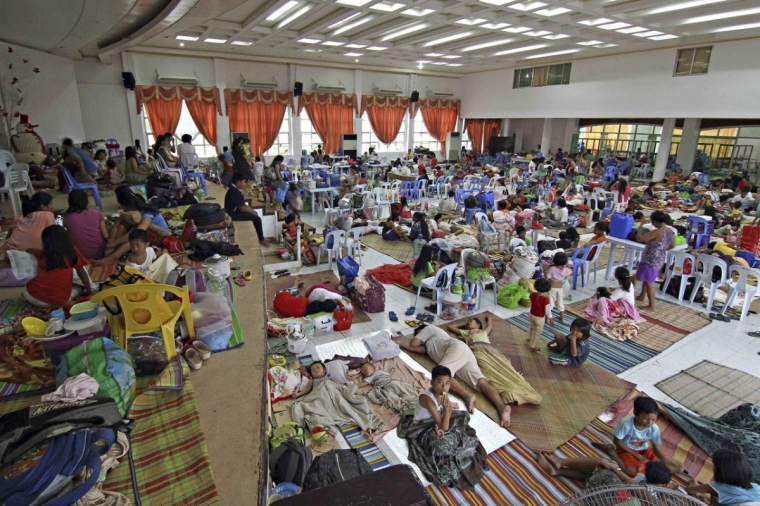Typhoon Hagupit (Ruby) Latest News Update: 21 Dead, More than One Million Affected

The death toll for Typhoon Hagupit rises in the Philippines with 21 people already confirmed dead and a million others affected. Hundreds of thousands are seeking help as they are left without food while their homes have been destroyed.
The National Disaster Risk Reduction and Management Council or NDRRMC said that 1,062,237 people were brought to evacuation centers for safety and food relief assistance.
These residents, according to the NDRRMC, belong to seven regions, 25 provinces, 188 municipalities and 1,547 villages. This list does not include those in southern Luzon, Metro Manila and Central Luzon who were also affected by the typhoon since Monday, December 8.
At the height of the typhoon, five airports were closed and 183 domestic flights were cancelled. Power outages were also experienced in many provinces. Because of the damage, major telecommunication providers currently have no services in the affected areas. National roads were closed due to fallen trees, landslides and floods.
Known in the Philippines as Typhoon Ruby, Typhoon Hagupit was recognized as a Category 4 super typhoon before it made landfall in the Philippines on December 6, specifically in Dolores, Eastern Samar.
It made its second landfall in Cataingan, Masbate the next day. On December 8, it made another landfall over Torrijos, Marinduque and over San Juan, Batangas on that same day. On December 9, Hagupit made its fifth landfall over Mabini, Batangas and its sixth and final landfall over Looc, Occidental Mindoro.
With memories of the super typhoon Haiyan, known in the Philippines as typhoon Yolanda, which brought unbelievable destruction a little over a year ago and killed more than 6,000 people, the government implemented strong evacuation efforts to prevent casualties during the height of Hagupit.
 Christians don't have to affirm transgenderism, but they can’t express that view at work: tribunal
Christians don't have to affirm transgenderism, but they can’t express that view at work: tribunal Archaeology discovery: Medieval Christian prayer beads found on Holy Island
Archaeology discovery: Medieval Christian prayer beads found on Holy Island Presbyterian Church in America votes to leave National Association of Evangelicals
Presbyterian Church in America votes to leave National Association of Evangelicals Over 50 killed in 'vile and satanic' attack at Nigerian church on Pentecost Sunday
Over 50 killed in 'vile and satanic' attack at Nigerian church on Pentecost Sunday Ukrainian Orthodox Church severs ties with Moscow over Patriarch Kirill's support for Putin's war
Ukrainian Orthodox Church severs ties with Moscow over Patriarch Kirill's support for Putin's war Islamic State kills 20 Nigerian Christians as revenge for US airstrike
Islamic State kills 20 Nigerian Christians as revenge for US airstrike Man who served 33 years in prison for murder leads inmates to Christ
Man who served 33 years in prison for murder leads inmates to Christ


 Nigerian student beaten to death, body burned over ‘blasphemous’ WhatsApp message
Nigerian student beaten to death, body burned over ‘blasphemous’ WhatsApp message 'A new low': World reacts after Hong Kong arrests 90-year-old Cardinal Joseph Zen
'A new low': World reacts after Hong Kong arrests 90-year-old Cardinal Joseph Zen Iran sentences Christian man to 10 years in prison for hosting house church worship gathering
Iran sentences Christian man to 10 years in prison for hosting house church worship gathering French Guyana: Pastor shot dead, church set on fire after meeting delegation of Evangelicals
French Guyana: Pastor shot dead, church set on fire after meeting delegation of Evangelicals ‘Talking Jesus’ report finds only 6% of UK adults identify as practicing Christians
‘Talking Jesus’ report finds only 6% of UK adults identify as practicing Christians Mission Eurasia ministry center blown up in Ukraine, hundreds of Bibles destroyed: 'God will provide'
Mission Eurasia ministry center blown up in Ukraine, hundreds of Bibles destroyed: 'God will provide' Church holds service for first time after ISIS desecrated it 8 years ago
Church holds service for first time after ISIS desecrated it 8 years ago Burger King apologizes for 'offensive campaign' using Jesus' words at the Last Supper
Burger King apologizes for 'offensive campaign' using Jesus' words at the Last Supper Uganda: Muslims abduct teacher, burn him inside mosque for praying in Christ’s name
Uganda: Muslims abduct teacher, burn him inside mosque for praying in Christ’s name